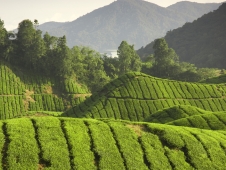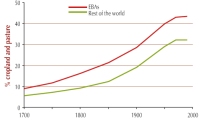
The impact of agriculture as a threat to Endemic Bird Areas (EBAs) can be derived by overlaying the distribution of EBAs with a map of global agricultural expansion. This shows that by 1990, 43% of EBA land area had been converted to agriculture, compared to 32% of the rest of the Earth’s land area.

Agriculture—defined here as arable land, perennial crops and permanent pasture (FAO 2001)—is normally associated with human settlements, so the spread of human population density (Tobler et al. 1995) can be used to estimate agricultural expansion over the planet. These changes have been reconstructed by the History Database of the Global Environment (HYDE; Klein Goldewijk 2001), using a model that tracks historical agricultural expansion across the world. The results show that, globally, the area of agricultural land has increased six-fold during the past 300 years. In 1700, less than 6% of the global land area was used for agriculture, whereas today’s figure is c.32% (figure a). Much of the remaining land is unsuitable for agriculture and a disproportionate amount of the usable land is concentrated in areas that are important for biodiversity.

The impact of agriculture as a threat to Endemic Bird Areas (EBAs, globally important centres of biodiversity) can be derived by overlaying the distribution of EBAs onto such a map of global agricultural expansion (Scharlemann et al. 2005). This shows that EBAs have been much more extensively transformed by agricultural expansion than the rest of the world (figure b). By 1990, 43% of EBA land area had been converted to agriculture, compared to 32% of the rest of the Earth’s land area (excluding the Antarctic).
Related Case Studies in other sections
References
Compiled: 2004 Last updated: 2008
Recommended Citation:
BirdLife International (2008)
Globally, agricultural land has expanded six-fold since 1700 and Endemic Bird Areas have suffered .
Downloaded from https://datazone.birdlife.org/sowb/casestudy/globally-agricultural-land-has-expanded-six-fold-since-1700-and-endemic-bird-areas-have-suffered- on 22/12/2024